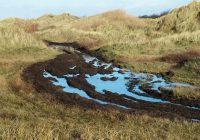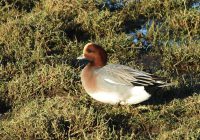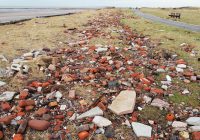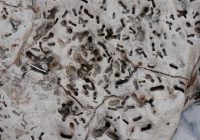Dr Phil Smith’s Wildlife Notes
January 2014
The weather for January was described as “relentlessly disturbed” with several episodes of gales, while precipitation on 25 days produced a regional rainfall total 70% above average. Despite this, the dune water-table was at least 60cm below last winter’s record peak, many slacks remaining dry throughout. Another storm surge occurred on 3rd , when a 10.1m tide took another chunk off Formby Point. However, because the wind had more of a southerly component, erosion was not as severe as on 5th December.
As if there hadn’t been enough damage to the dunes this winter, there was a series of major incidents involving large off-road vehicles in mid-late January. According to Coast & Countryside staff, some of these took place at night, apparently to avoid detection. The Birkdale frontal dunes and Green Beach area were severely impacted, some of the richest slacks for wildflowers being churned into a morass of mud. These included our best site for Baltic Rush, which occurs nowhere else in England, and part of one of the largest colonies of Flat-sedge, which is Red Data Book-listed and nationally declining. Several orchid colonies were also wiped out. Similar damage took place at Ravenmeols with extensive scarring of the fixed-dunes in the vicinity of Alexandra Road and deep rutting of a nearby botanically-rich slack. Attempts were also made to get into Devil’s Hole but the steep slopes defeated the vehicles, one of which was described as a “black Range Rover” by a local resident. Rangers are doing their best to catch and prosecute the culprits and the general public is asked to report any incidents, preferably with the registration numbers of vehicles.
Another area affected by the surge tides was the shell-beach dunes at Southport, opposite the northern end of the Marine Lake. A visit on 9th showed that, although the low dunes had been overwashed, the broad sand-flats took a lot of the energy out the waves and the dunes survived without cliffing. I was pleased to find a flock of 45-50 Twite feeding on seeds in tidal drift. Nearby, the Great Northern Diver was still performing on the lake but this seems to have been its last day here. A long-staying Long-tailed Duck was still at Marshside on 11th, when I estimated an impressive number of 12,000 Wigeon on the RSPB’s partially-flooded grazing-marsh, wonderful views being had from the old eastern seawall.
On my way to Blundellsands on 12th, I was surprised to find about 800 Pink-footed Geese feeding right next to the road on a Little Crosby rugby pitch. As might be expected, several scare-crows had been put up but the geese were ignoring them. At Hall Road, further effects of the storms were apparent. At least a metre of the rubble embankment had been washed away, bricks and large blocks of stone having been thrown up towards the cycle-track by the force of the waves. It was upsetting to see the enormous quantities of plastic waste washed up and then blown into the dunes.
It was fascinating to visit the exposures of silt on the shore north of Victoria Road on 14th with Alison Burns of Manchester University. She is studying the famous Formby Footprints and showed us tracks of horses and Red Deer, as well as a single well-defined human footprint, of which she took a plaster cast. I had previously found lots of footprints of wading birds here and also what appeared to be holes produced by their probing bills. Gordon Roberts confirmed that he had never recorded these during his prolonged studies.
The Devil’s Hole was disappointingly dry on 16th but a pair of Ravens croaking away overhead raised the spirits somewhat, while a Little Egret on the fields east of Cabin Hill was unusual here. A large Fox Moth caterpillar on a dune path was a reflection of the continuing mild winter.




